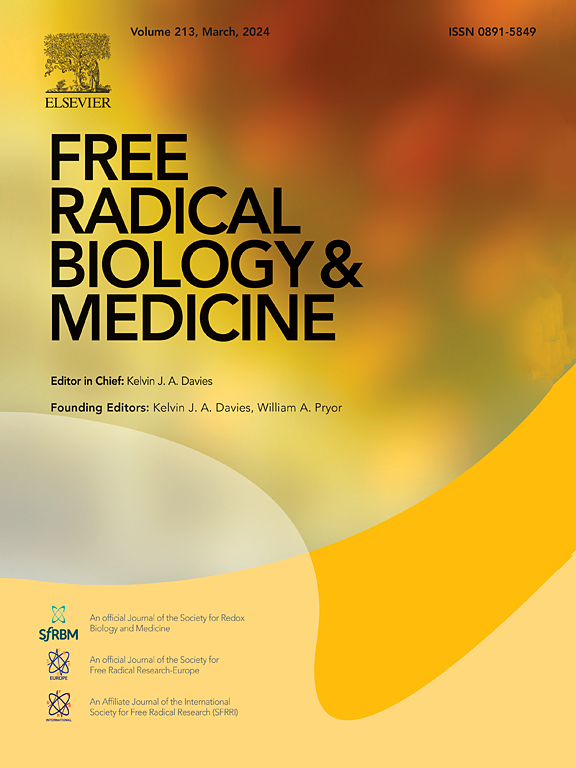过氧自由基对人葡萄糖6-磷酸脱氢酶(G6PDH)的失活作用受到其底物和辅因子的强烈调节。
IF 7.1
2区 生物学
Q1 BIOCHEMISTRY & MOLECULAR BIOLOGY
引用次数: 0
摘要
葡萄糖6-磷酸脱氢酶(G6PDH)是戊糖磷酸途径(PPP)的限速酶。该酶催化葡萄糖6-磷酸(G6P)氧化为6-磷酸葡萄糖酸内酯,同时将NADP+还原为NADPH。尽管PPP与氧化应激之间存在联系,但尚未对人类G6PDH (hG6PDH)活性的氧化及其后果进行研究。在本工作中,我们报道了AAPH(2,2'-偶氮(2-甲基丙脒)二盐酸)热裂解产生的过氧自由基(ROO=)介导的hG6PDH氧化失活。hG6PDH (46.4 μM,单体)在37℃、10或100 mM AAPH下孵育。在规定的时间,测定酶的活性(在340 nm处测定NADPH释放),用LC-MS研究修饰图,用圆二色分析结构变化,并通过硅分析酶的三维结构来合理化结果。在NADP+或G6P以过量或1:1 (hG6PDH:NADP+或G6P)摩尔比存在下进行了类似的实验。观察到ROO=对hG6PDH的高失活敏感性,3.6 mol ROO=使1mol hG6PDH失活。这种行为至少部分是由于位于NADP+结构位点附近的Trp349的氧化而合理化的。G6P的存在显著增加了ROO=介导的hG6PDH的失活,而NADP+的存在则观察到相反的效果,尽管在不同的位点氧化,酶的活性几乎没有被ROO=改变。这些结果表明,hG6PDH高度容易受到ROO=介导的失活,而这些过程受到G6P和NADP+的强烈调节。本文章由计算机程序翻译,如有差异,请以英文原文为准。

Inactivation of human glucose 6-phosphate dehydrogenase (G6PDH) by peroxyl radicals is strongly modulated by its substrate and cofactor
Glucose 6-phosphate dehydrogenase (G6PDH) is the rate-limiting enzyme of the pentose phosphate pathway (PPP). This enzyme catalyzes the oxidation of glucose 6-phosphate (G6P) into 6-phosphogluconolactone with concomitant reduction of NADP+ to NADPH. Despite the link between the PPP and oxidative stress, the oxidation and consequences on the activity of the human G6PDH (hG6PDH) has not been investigated. In the present work we report the oxidative inactivation of hG6PDH mediated by peroxyl radicals (ROO•) generated by AAPH (2,2′-azobis(2-methylpropionamidine) dihydrochloride) thermolysis. hG6PDH (46.4 μM, monomers) was incubated at 37 °C with 10 or 100 mM AAPH. At defined times, enzyme activity was determined (NADPH release followed at 340 nm), mapping of modifications studied by LC-MS, structural changes analyzed by circular dichroism, and results rationalized by in silico analysis of the three-dimensional structure of the enzyme. Analogous experiments were developed in the presence of NADP+ or G6P at excess or 1:1 (hG6PDH:NADP+ or G6P) molar ratios. High susceptibility to inactivation by ROO• was observed, 3.6 mol of ROO• inactivated 1 mol of hG6PDH. This behavior is rationalized, at least in part, by oxidation at Trp349 which is located close to the structural site of NADP+. The presence of G6P significantly increased the ROO•-mediated inactivation of hG6PDH, while an opposite effect was observed in the presence of NADP+ where, despite oxidation at different sites, the enzyme activity was practically unaltered by ROO•. These results demonstrate that hG6PDH is highly susceptible to inactivation mediated by ROO• with these processes strongly modulated by G6P and NADP+.
求助全文
通过发布文献求助,成功后即可免费获取论文全文。
去求助
来源期刊

Free Radical Biology and Medicine
医学-内分泌学与代谢
CiteScore
14.00
自引率
4.10%
发文量
850
审稿时长
22 days
期刊介绍:
Free Radical Biology and Medicine is a leading journal in the field of redox biology, which is the study of the role of reactive oxygen species (ROS) and other oxidizing agents in biological systems. The journal serves as a premier forum for publishing innovative and groundbreaking research that explores the redox biology of health and disease, covering a wide range of topics and disciplines. Free Radical Biology and Medicine also commissions Special Issues that highlight recent advances in both basic and clinical research, with a particular emphasis on the mechanisms underlying altered metabolism and redox signaling. These Special Issues aim to provide a focused platform for the latest research in the field, fostering collaboration and knowledge exchange among researchers and clinicians.
 求助内容:
求助内容: 应助结果提醒方式:
应助结果提醒方式:


